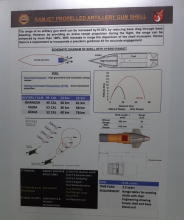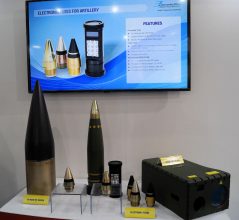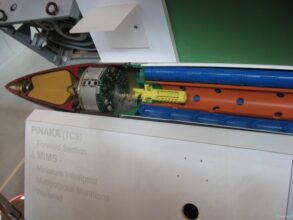The development of a Ramjet powered artillery round was proposed by the Indian Institute of Technology-Madras (IIT-M) during DefExpo-2020.
This article looks at the R&D work ongoing in the development of the ramjet technology & the propellant used by the engine. The article also speculates about the guidance & navigation systems, artillery fuzes & other systems that will be needed on the ramjet-powered artillery round.
All information on this article is taken from publicly available research journals, news articles etc.
The need for a Ramjet powered artillery shell
A base bleed artillery round can increase the range of a traditional round by 10-20%. A ramjet-powered artillery round can increase range by over 100%.
Indian Army’s Artillery units engage targets inside Pakistan quite regularly. A doubling of the range will allow the artillery units to hit targets much deeper inside Pakistan at a relatively lower cost. Thereby increasing the effectiveness of Artillery along the LoC.

About the Team
Former Director-General of Artillery of the Indian Army Lt. Gen. P. R. Shankar (retired) is leading the project.

The project management and user inputs are coming from Col. Rajneesh Iyer of the Indian Army’s School of Artillery. IIT-M researchers are doing most of the work with support from DRDO. IIT-Kanpur & RCI-Hyderabad will be handling the development of the Precision Guidance Kit (PGK).
It is not every day that we see the military involved in any project from its onset, guiding the development. We are more used to seeing organizations working in silos or working against each other rather than working together. This is a nice change of pace.
The team says they will need around INR 9.95 crores (US $ 1.35 million) for this project. The estimated timeline is around 2.5 years. The MoD hasn’t officially approved this project yet. Or at least they haven’t made it public.
Preliminary design of the Ramjet artillery shell
IIT Madras put out a paper on their ramjet-powered artillery round sometime back. The paper is titled: ” Solid Fuel-rich Propellant Development for use in a Ramjet to Propel an Artillery Shell “

As the design shows, the addition of the ramjet engine will drastically reduce the size of the warhead. A ramjet-powered artillery round will travel much farther, but it will produce less bang per round.
Analysis of the propellant to be used in the ramjet round
The propellant used must have the following qualities :
- To prevent accidental detonation the propellant must be shock resistant.
- It must be a sufficiently fast burning fuel allowing the shell to fly faster. The size & mass restrictions means a propellant with high energy density in needed.
- The propellant must have a greater proportion of fuel to oxidiser. In other words, the propellant must be fuel rich.
- The fuel must undergo complete combustion leaving minimal amount of solid residue behind.
- It must be cheap to produce. If the propellant is expensive then mass production will be a very expensive prospect. That will diminish the promise of this tech.

Material Selection
The new propellant will have proven components. This will reduce risks. The components are :
Aluminum (Al) : Fuel
Iron Oxide (IO) : Desensitized reactant.
Hydroxyl Terminated Poly Butadiene (HTPB) : Binder
Poly Tetra Fluoro Ethylene (PTFE) : Activator
Ammonium Perchlorate (AP) : A very powerful oxidiser
Let’s go over them one by one :
Aluminium(Al) & Iron Oxide(IO) :
The Aluminum used here is not a bar/lump of metal. Rather it is in fine powder form. Produced by high energy ball milling or attrition milling of Aluminum pellets.
Why is making a powder important ?
The reactivity of a metal is subject to the available surface area. A powder has more surface area than a bulk metal of the same mass. Thus powdered Aluminum is more reactive than bulk. Aluminum is used in composite solid propellants to increase energy output. This is done by using a very exothermic reaction called “Thermite reaction”.
In a thermite reaction aluminum is oxidized by oxide of another metal, commonly iron oxide. Although the reactants are stable at room temperature, when they are exposed to sufficient heat they burn & release a lot of energy. Thermite contains its own supply of oxygen, and does not require any from air. Consequently, it cannot be smothered and may ignite in any environment, given sufficient initial heat.
The reaction is : Fe2O3 + 2 Al –—> Al2O3 + 2 Fe + Energy
The energy produced is around ~2000 Kilo joules/gm of Al. However, the reactants need to be heated to over a 1000 deg C for the reaction to begin. So kick starting the reaction is not easy. It will require some other energy source. That’s where the other components come in.
Hydroxyl Terminated Poly Butadiene(HTPB) :
This is the polymeric binder holding the entire composite propellant together. It is combustible and burns leaving no solid residue behind. It produces enough energy on combustion, in certain propellants HTPB is both the binder and the fuel. HTPB is not a new thing by any measure. Various types of missiles & space launch rockets use HTPB widely. ISRO uses it on the SSLV, PSLV & other rockets. We already have huge production facilities for HTPB, we are currently one of the largest producers globally. So production and sourcing isn’t a problem and is quite economical. The propellant has a very high proportion of binder. Thus its price, availability etc. plays directly into the overall cost per round.
Poly Tetra Fluoro Ethylene (PTFE) & Ammonium Perchlorate(AP) :
The PTFE is the activator or the material with the lowest melting temperature(~300 deg C). A 155mm artillery gun has a muzzle velocity of over Mach 2. Air rushing in through the inlets will easily heat up beyond 300 deg C. This will cause the PTFE to melt and release Florine gas, increasing pressure and further heating up the combustor. Then the AP will take over, quickly breaking down and releasing a lot of oxygen. Thus the pressure & temperature will further increase. The increased temperature will now ignite the HTPB, which will again increase temperature and increase pressure. Once the temp is above 1000 deg C and the pressure is high enough the thermite reaction begins.
It is a multi-step combustion process, of course the pressure and temperature are dynamic. The shell will keep ejecting hot gasses from the secondary nozzle the entire time. So the parameters inside the shell will depend on the rate of reactions. Of course, the problem with multi-step combustion is that the reaction rates, energy outputs etc are different for different reactions. For example, when the thermite reaction initiates there will be a sudden surge of energy output, that might de-stabilize the flight of the round and throw it off target. It will be interesting to see how they go about dealing with these problems.
Charecterisation of the propellant used in the ramjet round
They have experimented with these compositions of fuel-rich propellants:

The activated Aluminum powder taken is 6.5 micron in diameter. It is pyral in the propellant mix i.e. the material that burns and produces the maximum energy. The F5 composition contains a trace amount of Iron Oxide needed for the thermite reaction.

Here we can see how the burn rate of the propellant relates to the measured & theoretical densities of the propellant mix. This is an area that requires an onerous balancing. If the burn rate too high the speed achieved by the shell will be higher, but the propellant will burn out sooner too. Thus the overall range achieved will be less. This goes the other way too, slow burn rate means lower speed but longer range.
Thus, there is a need for a balance:
- The burn rate should be low enough to give the Artillery round a good range margin over traditional base bleed or boat tail rounds. This should justify the cost incurred in the acquisition of such rounds.
- The burn rate should be high enough to ensure the round is fast. It should be able to avoid Counter-Rocket Artillery & Mortars (C-RAM) systems, in case the enemy acquires any in the future.
The next test was on the combustor pressure requirements of the different propellant compositions.

The ramjet needs to ignite soon after the shell leaves the barrel. The lower the combustor pressure requirement the easier it is to get the engine to ignite.

Like traditional artillery rounds, the ramjet round will also be fired off using explosive charges. Thus the change in temperature sensitivity with respect to pressure is an important measure.
In all chosen metrics the F5 propellant mix held up pretty good in lab experiments, therefore the F5 composition was chosen for further experimentation. Further experimentation on the ramjet engine may bring some changes to the propellant composition.

DRDO’s contribution :
The propellant samples were prepared & sent to DRDL for testing. DRDL stands for Defence Research and Development Laboratory. It is a Missile System laboratory – under the DRDO
The results validate the usability of the propellant in the Ramjet Artillery rounds. Interestingly, DRDL concluded that the propellant can increase the range of the Akash missile from 30 km to 45 km. But that’s a different subject. The Akash missile’s successor Akash NG is almost ready to begin flight tests anyway.
Artillery Fuzes
Indian companies like BEL already make electronic fuzes of various sizes, adopted for various modes of detonation. The Army is a major customer of these.

Adopting these fuzes for use on the Ramjet round would require some minor design changes. This is not a major problem & is very much doable.
Guidance & Navigation Kit
The Army’s first exposure to guided artillery rounds came when the imported from Russia the Krasnopol laser-guided artillery round. The recent acquisition of the M982 Excalibur from the US adds to our precision-guided artillery arsenal.
The only domestically made artillery system with GPS based guidance system is the Guided Pinaka rocket artillery.


The Guided Pinaka has a CEP of 7-80 m at 80-90 km range. With the Trajectory Correction System(TCS) it can come down to 5-30 m CEP at 90km. The Excalibur, in comparison, has a 5-20 m CEP at 30-40 km range.
If the ramjet round uses a GNC kit based on that seen on the Pinaka then its accuracy would be pretty contemporary. Using the NAVIC/IRNSS navigation satellites, instead of the American GPS, accuracy can be further improved. The IRNSS offers better accuracy over the Indian subcontinent, though it is not a global system.
The Pinaka is 215mm in diameter while the artillery round is 155mm. Before being ported to a 155mm shell, the GNC kit will have to be miniaturised.
Next Generation Fire Control Network
IIT Madras has made significant progress on an indigenous Processor called ‘Shakti’. They have recently unveiled the MOUSHIK processor for IOT applications.

In DefExpo 2020, IIT-Madras stated that it is now building the Next Generation of Artillery Combat Command and Control Network(ACCS).
The ACCS integrates the information from various sensors, inputs from various units deployed etc to produce a combined operational picture. This allows the Army’s Artillery commanders to make decisions that more effectively utilize available firepower to maximum effect.
The new fire-control network proposed will be based on Shakti processor in a lightweight tablet configuration. It will be a precursor to secure net-centricity in the Armed Forces incorporating all-new weapon systems.
The Fire Control Network & the Ramjet powered Artillery shell is being built by the same organisation. This should allow maximum synergy between the systems involved.
Check out our Twitter thread on India’s progress in the micro-processor & micro-controller space :
Conclusion
With the currently projected ranges, a ramjet powered artillery shell fired from the Advanced Towed Artillery Gun System (ATAGS) would be able to hit the target at almost 80 km. If the ramjet round can prove the same accuracy as the Pinaka it would be a gamechanger as artillery rounds are usually much cheaper to produce.
Given how our neighbour to the west doesn’t have much depth of territory. A cheap long-range precision strike weapon that can be mass-produced will further compound problems for them. We must continue developing and fielding such systems to increase the cost of proxy wars & artillery duels along the LoC.
For Discussions: http://www.strategicfront.org/forums/threads/development-of-an-indian-ramjet-powered-artillery-round-the-story-so-far.4122/
